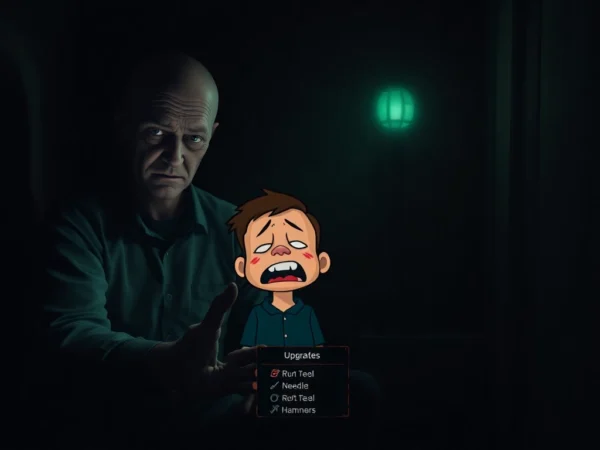BloodMoney: The Psychological Horror of Moral Decay in a Dark Clicker Game
Overview and Context of BloodMoney: A Psychological Darkness Unveiled
In the realm of indie psychological horror games, bloodmoney stands out as a haunting exploration of morality, human suffering, and the lengths one will go to survive. Unlike traditional horror titles that rely on jump scares or overt violence, BloodMoney delves into the unsettling territory of moral decay, forcing players to confront their own ethical boundaries through a simple yet profoundly disturbing mechanic: clicking. The game presents a visceral experience where each action, each click, is a step further into a moral abyss, challenging players to weigh their survival against the suffering they inflict. As you navigate this dark clicker game, you are faced with a stark choice: how much are you willing to sacrifice your morals for the chance to save your life?
BloodMoney Game Mechanics: An Intimate Look at the Core Gameplay
Clicking for Survival
The fundamental mechanic of BloodMoney revolves around clicking on Harvey, a cheerful yet increasingly unsettling character who offers a means to earn money. Each click generates a dollar, which is desperately needed to cover a staggering $25,000 medical bill. The gameplay is deceptively simple—click, earn, and watch your funds grow—but this simplicity masks a profound psychological tension. As the player clicks, Harvey’s appearance and reactions subtly change, signaling the toll the process takes on him. The more you click, the more pain and suffering Harvey endures, creating a visceral link between your actions and his torment.
Upgrade System and Increasing Disturbance
Progression in BloodMoney is driven by upgrading tools from the shop, which exponentially increase earnings per click. These upgrades include needles, scissors, hammers, and even more violent implements as the game progresses. Each upgrade not only boosts profits but also amplifies Harvey’s suffering, with visual and audio cues intensifying the unsettling atmosphere. The game cleverly balances reward with risk, as choosing more violent tools accelerates your path to financial goals but at a moral cost. The upgrade system embodies a twisted risk-reward dynamic—each enhancement comes with psychological and visual consequences, forcing players to consider whether profit is worth the moral degradation.
The Dark Narrative of BloodMoney and the Harvey Community Insights
The Story Behind the Clicks
At its core, BloodMoney tells the story of a person diagnosed with a life-threatening illness, desperately needing $25,000 for treatment. The game introduces Harvey, a seemingly kind-hearted character who offers a disturbing solution: click on him to generate income. Initially innocent—Harvey appears cheerful and unaware of the pain inflicted—yet as the gameplay continues, the narrative darkens. Harvey’s reactions grow more distressed, and visual cues reveal the toll exacted on him. The game subtly hints that Harvey may not fully comprehend the severity of what is happening, especially as the shop offers more violent tools that seem out of character for his cheerful persona.
Community Perspectives and Player Reactions
Players often describe their experience with BloodMoney as deeply unsettling yet compelling. Many note the emotional impact, especially when Harvey’s reactions become more distressed or when the visuals grow increasingly disturbing. Comments from the community highlight how the game cleverly uses subtle cues—Harvey’s surprised reactions to violent tools, his changing facial expressions, and the dialogue—to evoke empathy and guilt simultaneously. Some players have expressed that the game feels like a mirror reflecting human nature: how far are we willing to go when pushed to the brink? The community’s shared insights reveal a collective grappling with the moral implications, often leading to intense debates about the nature of morality, survival, and human suffering.
Featured Gameplay Videos and Clicking Mechanics
Watching the Darkness Unfold
Gameplay videos of BloodMoney reveal the gradual spiral into darkness. Viewers observe how players’ choices influence the storyline and final outcome. The clicking mechanic, deceptively simple, becomes a tool of moral exploration—each click a moral choice. As players click, they observe Harvey’s changing expressions, from cheerful to pained, and the increasing intensity of visual effects. Many videos highlight the moment when players unlock the more violent upgrade tools, such as hammers and needles, which drastically escalate Harvey’s suffering. These videos serve as stark visual testaments to the game’s emotional power, illustrating how a straightforward mechanic can evoke profound moral questions.
Upgrade System: Amplifying Profit and Morality Tests
Tools of Descent
The upgrade shop in BloodMoney is where the game’s dark complexity truly manifests. Initially, upgrades are harmless—perhaps pillows or soft objects—but as the player advances, the options become more violent and disturbing. These include needles, scissors, hammers, and even more grotesque implements. Each upgrade increases earnings exponentially but also causes Harvey more pain, visually represented through his facial expressions, body language, and environmental effects.
Psychological Impact of Upgrades
The game employs a clever psychological device: Harvey’s surprise at more violent tools suggests he is unaware of their true nature, implying he expects harmless items. This introduces a moral gray area—are we responsible for the suffering we cause blindly? The upgrades, therefore, are not just gameplay mechanics but symbols of moral choices, testing whether players prioritize profit over empathy. The visual cues—Harvey’s pain reactions and the grotesque visuals—serve to deepen this moral conflict, making every upgrade a moral gamble.
Visual and Narrative Techniques: Building Unrest and Unease
Subtle Visual Cues
BloodMoney masterfully creates an unsettling atmosphere through subtle visual cues. Harvey’s facial expressions shift from cheerful to distressed, and the environment darkens as the game progresses. The game employs color grading, lighting effects, and disturbing imagery that intensify with each click. These visual techniques create a sense of mounting dread, making players acutely aware of the moral cost of their actions.
Narrative Dialogue and Sound Design
The dialogue is sparse but impactful, with Harvey’s words reflecting his confusion, fear, and pain. The sound design complements this with unsettling background noises, muffled cries, and eerie music that heighten the tension. This combination of visual and auditory storytelling immerses players in a psychological nightmare, emphasizing the human cost of their greed and desperation.
Multiple Endings: The Power of Choice and Morality
Three Paths, Three Outcomes
BloodMoney offers three distinct endings based on the player’s choices—each reflecting a different moral stance:
- The Good Ending: Minimizing Harvey’s suffering, even if it means slower progress. This ending showcases empathy and moral integrity, emphasizing that profit should not come at the expense of suffering.
- The Normal Ending: A balanced approach—using moderate violence and upgrades, leading to a middling moral outcome. It reflects a compromise between survival and conscience.
- The Bad Ending: Maximizing profit regardless of Harvey’s pain, employing the most violent tools and quickest methods. This route depicts moral failure and complete ethical decay, ending in Harvey’s profound suffering and a bleak conclusion.
The game subtly tracks player behavior, including the choice of tools, reactions to Harvey’s suffering, and the frequency of violent upgrades, which influence the final outcome. This design encourages replayability and moral reflection, prompting players to consider how their decisions mirror their own values.
Community Insights and Player Reactions
Discussions and Theories
Online forums and gameplay videos reveal a vibrant community engaged in dissecting BloodMoney’s themes. Many players share their experiences, debating whether the game is a critique of capitalism, a reflection on human cruelty, or a test of moral resilience. Some highlight the surprising depth hidden within the seemingly simple clicker mechanic, noting how it forces introspection about real-world decisions and ethical boundaries.
Emotional Impact and Ethical Reflection
Players often recount feelings of guilt, empathy, or philosophical contemplation after playing. The game’s design evokes genuine emotional responses, making players question if their choices are justified or morally acceptable. Such reactions demonstrate the game’s success as a psychological tool—challenging players to confront uncomfortable truths about human nature and their own morality.
The Game’s Reflection on Morality and Humanity
Harvey as a Symbol
Harvey embodies innocence and trust, a character caught in a cruel experiment that tests the limits of human empathy. His reactions—surprised by violence, distressed by pain—serve as mirrors for our own moral compass. The game subtly suggests that beneath our desire for survival lies a complex web of morality, empathy, and darkness.
The Dark Mirror of Human Nature
BloodMoney questions whether humans are inherently good or evil when faced with desperation. The game’s mechanics and narrative imply that everyone has a moral threshold—one that varies based on circumstances. The community’s varied endings and strategies reflect this diversity, illustrating that morality is often a matter of perspective and context.
Comparative Analysis: BloodMoney and Similar Psychological Horror Games
Unique Mechanics and Themes
Compared to other psychological horror titles, BloodMoney distinguishes itself with its minimalist clicker mechanic intertwined with profound moral questions. While games like “Papers, Please” or “The Stanley Parable” explore ethical dilemmas through narrative choices, BloodMoney immerses players in a visceral, visual test of morality through simple interactions. Its emphasis on visual cues and emotional engagement creates a uniquely disturbing experience.
Influences and Inspirations
The game draws inspiration from psychological horror classics that probe human nature, such as “Lemmings” , and horror titles like “Silent Hill” or “Amnesia” that evoke atmosphere and emotional depth. BloodMoney’s innovative approach to combining a clicker mechanic with dark storytelling pushes the boundaries of indie horror design.
Final Thoughts: Confronting Ethical Boundaries in the Dark
BloodMoney is more than a game; it’s a psychological mirror reflecting our own moral boundaries. It challenges players to consider the cost of survival, the nature of suffering, and the darkness that lurks within us all. The game’s narrative and mechanics serve as a stark reminder that even in the simplest actions—like clicking—lie profound ethical implications. As you progress through the game, you are forced to ask yourself: how far are you willing to go when your life hangs in the balance? And in that answer lies the true terror of BloodMoney.
Ultimately, the game’s power lies in its ability to evoke empathy and guilt while offering a disturbing commentary on human nature. Whether you choose the path of mercy or ruthless efficiency, your decisions define your morality—and your fate. The haunting question remains: are we inherently good, or is our morality merely a fragile veneer? BloodMoney masterfully explores this dilemma, testing the limits of human decency in a dark, click-driven nightmare.
For those intrigued by this psychological descent, further exploration awaits in related titles and fan communities. But remember, every click in BloodMoney is a step into moral darkness—are you prepared to face the consequences? Discover the game’s profound depths, and see how your choices shape Harvey’s fate and your own moral landscape. Dive into the disturbing world of bloodmoney and confront your own ethical boundaries today.


